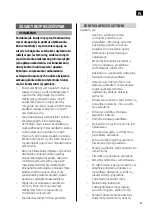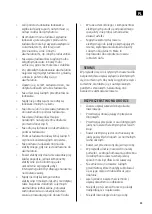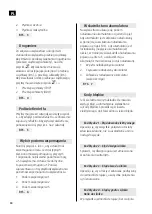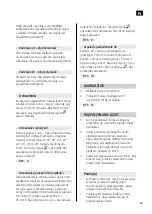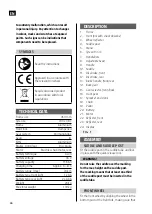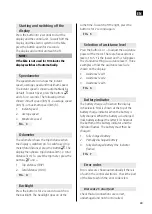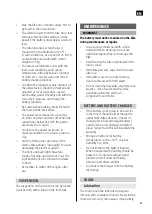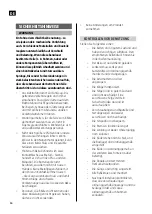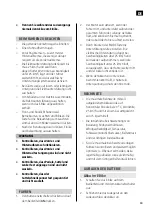
EN
45
• Make sure that nobody, especially
children, touches the charger while
charging is in progress.
• Do not place any objects on the charger.
• Make sure your hands are not wet when
connecting or disconnecting the charger.
• Do not turn or move the charger or
battery while charging is in progress.
• Do not use the charger in direct sunlight.
• Do not disconnect the charger from the
battery while charging is in progress.
• Do not carry out any maintenance on the
bike while charging is in progress.
• Do not connect the charger to the mains if
it is not connected to the battery.
• The electric bike works reliably in all kinds
of weather, but the electrical components
and/or motor can be damaged during
prolonged or excessive exposure to water.
• Do not touch the electrical components
with wet hands, or touch the positive and
negative terminals on the battery at the
same time; short circuiting can result in
personal injury.
• If there is a fault on any of the electrical
components, consult a specialist. Do not
attempt to repair the fault yourself.
• Never use the electric bike for riding on
extreme terrain, jumping, or carrying
heavy loads. This can damage the electric
bike and result in personal injury.
SERVICE
Only use identical spare parts when replacing
parts that are essential for safety. Contact an
authorised service centre for original parts.
This will guarantee that the bike remains safe
to use.
ROAD SAFETY
• Always wear an approved bike helmet.
• Follow local traffic regulations.
• Follow the laws and regulations that apply
in your country when riding an electric bike.
• The electric bike is designed for normal
roads and in normal traffic.
• The bike is intended for one person.
• In slippery conditions – note that the
braking distance can be longer than
normal to stop the electric bike safely.
• Do not put anything on the bike that can
get caught up and obstruct the functions
of the bike.
• Use lights and reflectors when cycling in
the dark.
• Do not ride on the same side as oncoming
traffic.
• Do not ride alongside another bike.
• Do not give rides on bikes not intended for
this.
• Do not swing out into traffic.
• Do not hang anything from the
handlebars that makes it difficult to steer,
or which could fasten in the front wheel.
• Do not hang onto another vehicle.
• Do not ride too close to a vehicle in front.
• The braking power is reduced by water
and ice.
• Cycle more slowly in wet weather and
brake earlier than you normally do in dry
weather.
• Follow local regulations when cycling in
the dark. The bike must have a front lamp
with a white light and a back lamp with a
red light, plus the necessary reflectors.
• Wear bright clothes and a high-visibility
jacket if possible.
• Check that the bike’s reflectors are
correctly positioned, properly attached,
clean and not obscured. Replace
damaged reflectors immediately.
WARNING!
Like all mechanical components a bike is
also exposed to wear and fatigue. Different
materials and components show signs of
wear and fatigue in different ways. If a
mechanical component has reached the end
of its useful life this can cause the component
Содержание 01028174
Страница 4: ...1 2 1 2 3 4 6 5 7 8 9 ASSIST 1 20 10 3 12 4 21 23 2 3 5 16 17 19 18 14 11 13 9 24 15 22 7 8 6...
Страница 5: ...3 4 5 6 1 2 3 1 2 3...
Страница 6: ...7 8 1 2 3...
Страница 7: ...9 10 11...
Страница 8: ...12 13 1 2 5 1 H L 2 3 3 4...

